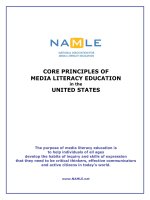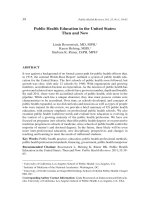Education in the United States
Bạn đang xem bản rút gọn của tài liệu. Xem và tải ngay bản đầy đủ của tài liệu tại đây (1.36 MB, 34 trang )
American Studies
Chapter 6
Education in the United
States
Lecturer: Vu Doan Thi Phuong Thao
University of Languages and International Studies,
Vietnam National University, Hanoi
CONTENT
• General overview
• The school system
• Other features
GENERAL OVERVIEW
• National education budget
(2010) : $904.6 billion (all levels)
• Literacy (2003)
• Men 97%
• Women 97%
• Enrollment: 76 million
• Primary: 37.9 million
• Secondary: 16.4 million
• Post-secondary: 17.5 million
GENERAL OVERVIEW
A large & diverse educational system, provided
mainly by government.
School attendance:
• Formal shooling starts at the at of 5.
• Public school: free & open to all (at elementary
& secondary levels)
• Attending school required until the age of 1618 depending on the state. Compulsory
school attendance
GENERAL OVERVIEW
Varied opportunity:
• Choice of courses
• Wide variety of degree program in higher
education
• Varied academic standards & reputation
Decentralized funding & administration:
• Educational standards and standardized
testing decisions are usually made by state
governments.
• Spending for public education is determined
by states and education leaders.
Cirriculm: No national school system & no
national curriculum
EDUCATION PHYLOSOPHY
• Education is universal
• Education is decentralized
• Education is comprehensive
• Education is professional
• Education pays attention to both intellectual
development and character building
• Education is of practical value
GENERAL OVERVIEW
US School
System
Public
• 3 types of school:
public, private, and
home-schooling.
• Most of private schools
are run by religious
groups.
Schools
in the
USA
• 85% of students enter
public schools.
Private
Homeschooling
THE SCHOOL SYSTEM
4. Higher Education
3. Secondary Education
The US’s
School System
2. Elementary Education
1. Pre-schooling
Pre-schooling
• Pre-schooling
programs offered
at the age of 3 or
4.
• Children attend
nursery school, day
care or pre-school.
Elementary Education
• Includes kindergarten and the next five or six
years of education (K-6th grade).
• Basic subjects are taught, traditionally the
three Rs : reading, writing and arithmetic.
• Other subjects, creative activites and sports
are included.
Elementary Education
• Pupils spend most of the day with
their class.
• The class is taught most of the
time by the same teacher.
• Elementary school teachers must
earn either a Bachelors or Masters
Degree in Early Childhood &
Elementary Education.
Secondary Education
• Divided into: Junior & Senior high
schools (middle school & high
school).
• Junior high school:
- Grade 7 and 8
- Ss take different lessons from different
teachers
- Ss are required to study certain
subjects, but can choose classes.
Secondary Education
• Senior high school:
- From grade 9 to 12.
- Take technical subjects such as computer
programming alongside with academic ones.
- Receive diploma when graduating.
- After high school, the majority of Ss go on to
college.
Secondary Education
Common types of electives
• Visual arts (drawing, sculpture, painting,
photography, film)
• Performing Arts
• Technology education
• Computers
• Athletics
• Publishing (journalism/student newspaper,
yearbook, literary magazine)
• Foreign languages (French, German, Spanish
are common; Chinese, Latin, Greek and
Japanese are less common)
Higher Education
• Undergraduate Studies for Bachelor’s Degree
(B.A, B.S.)
- Technical institutes
- Private career schools
- Colleges and universities
• Graduate Studies for Master’s Degree (M.A,
M.Sc.)
• Postgraduate Studies for Doctor’s Degree
(Ph.D.)
Colleges and Universities
• Colleges offer classes only for
undergraduate Ss for bachelor’s
degree in arts and sciences.
• Universities are larger than
colleges and also offer courses
for graduate Ss.
• Public colleges and universities
charge tuition but much lower
than private ones.
Colleges and Universities
• 25% of colleges and universities are privately
operated by religious groups.
• No distinction between the quality of education
provided at public and private colleges and
universities.
• Junior colleges or community colleges offering
two-year courses that lead to an ‘associate’s
degree’, then transfer to a different college or
university to continue their studies.
AMERICAN EDUCATION
SYSTEM SUM UP
American colleges &
universities
University of Columbia
Princeton University
University of Pennsylvania
American colleges &
universities
Massachusetts Institute of Technology
University of California, Berkeley
Colleges and Universities
• Admissions criteria to
go to college or
university:
• grades earned in high
school
• class ranking
• standardized test
scores (such as the
SAT or ACT tests).
Graduate study
Entrance into graduate programs depends upon:
• a student's undergraduate academic
performance
• professional experience
• the score on a standardized entrance exam (the
GRE (graduate schools in general), the LSAT
(law), the GMAT (business), or the MCAT
(medicine)
OTHER FEATURES
Varying tuition fees
depending on geographic
location, the school's
expenses, the availability of
funding from sources other
than tuition.
Private schools have various
missions:
• cater to college-bound students
• for gifted students, students
with learning disabilities or
other special needs, or
students with specific religious
affiliations.
Extracurricular activities
• Educational activities not
falling within the scope of the
regular curriculum but under
the supervision of the school.
• Develop students’
interpersonal skills.
• As important as the students’
class work.
• Include athletic activities,
musical groups, marching
bands, student government,
school newspapers, science
fairs, debate teams, and clubs
focused on academic areas.
No Child Left Behind Act
• Signed on January 8, 2002
• Reauthorizes federal
programs to improve the
performance of U.S.
primary and secondary
schools
• Requires states to set
educational standards for
achievement at different
grade levels and to take
steps to improve the
performance of those who
don’t meet the standards
• Provide parents more
flexibility in choosing
schools for their children.









